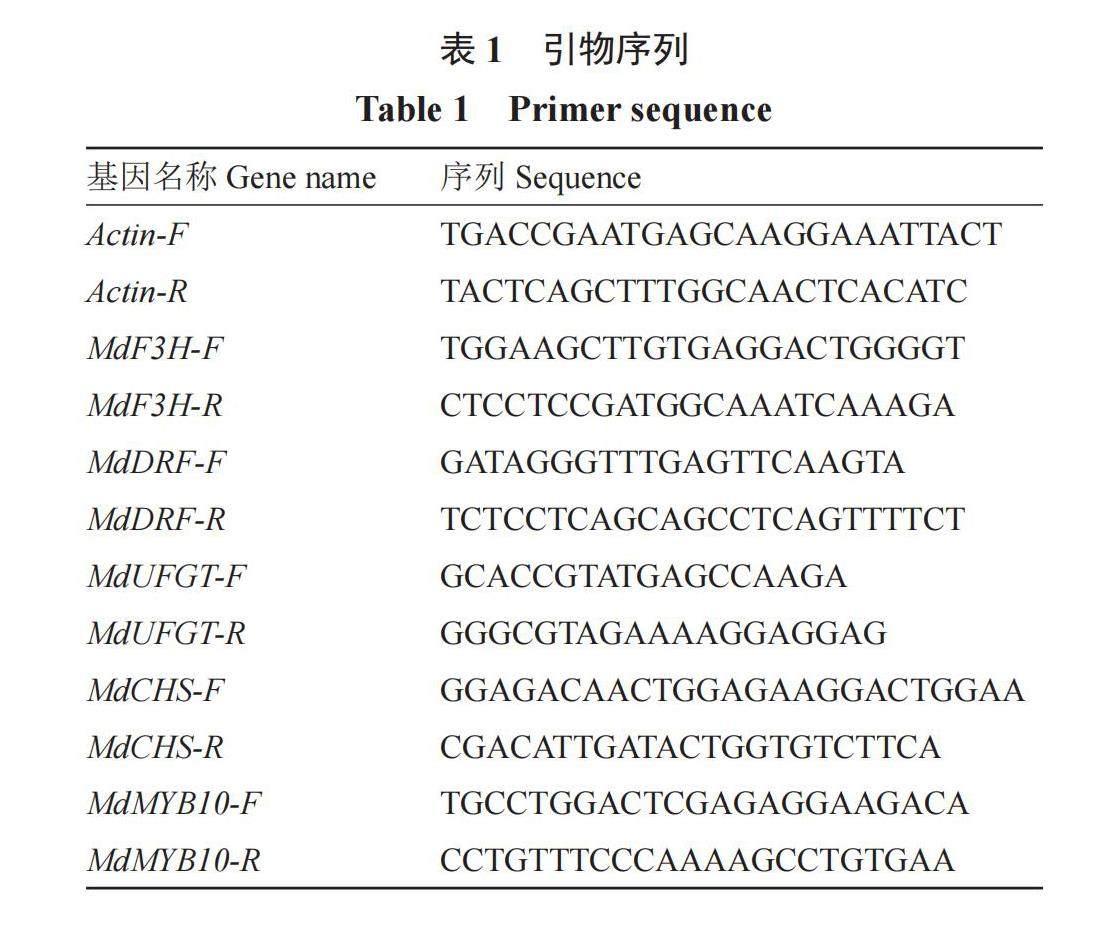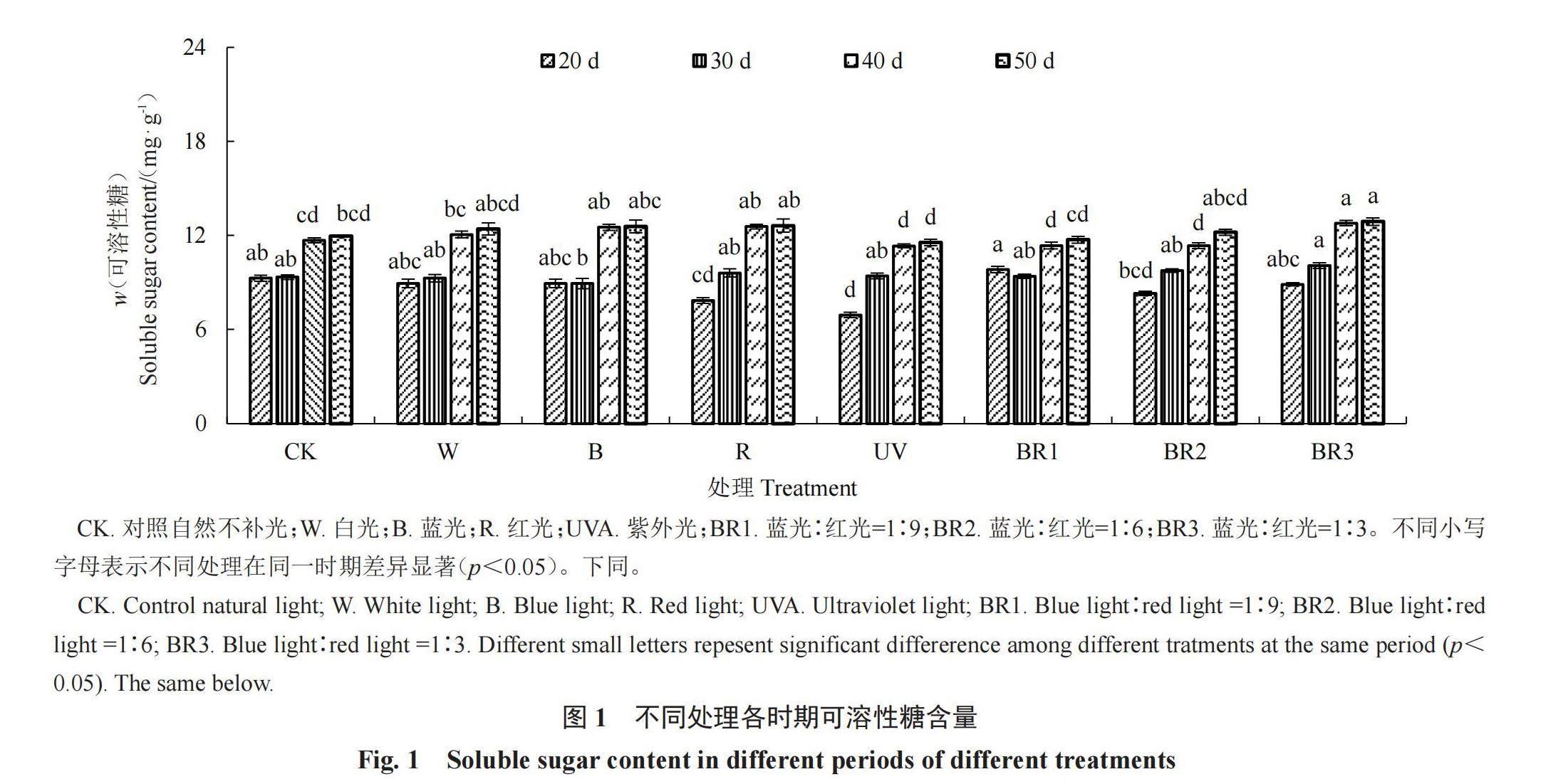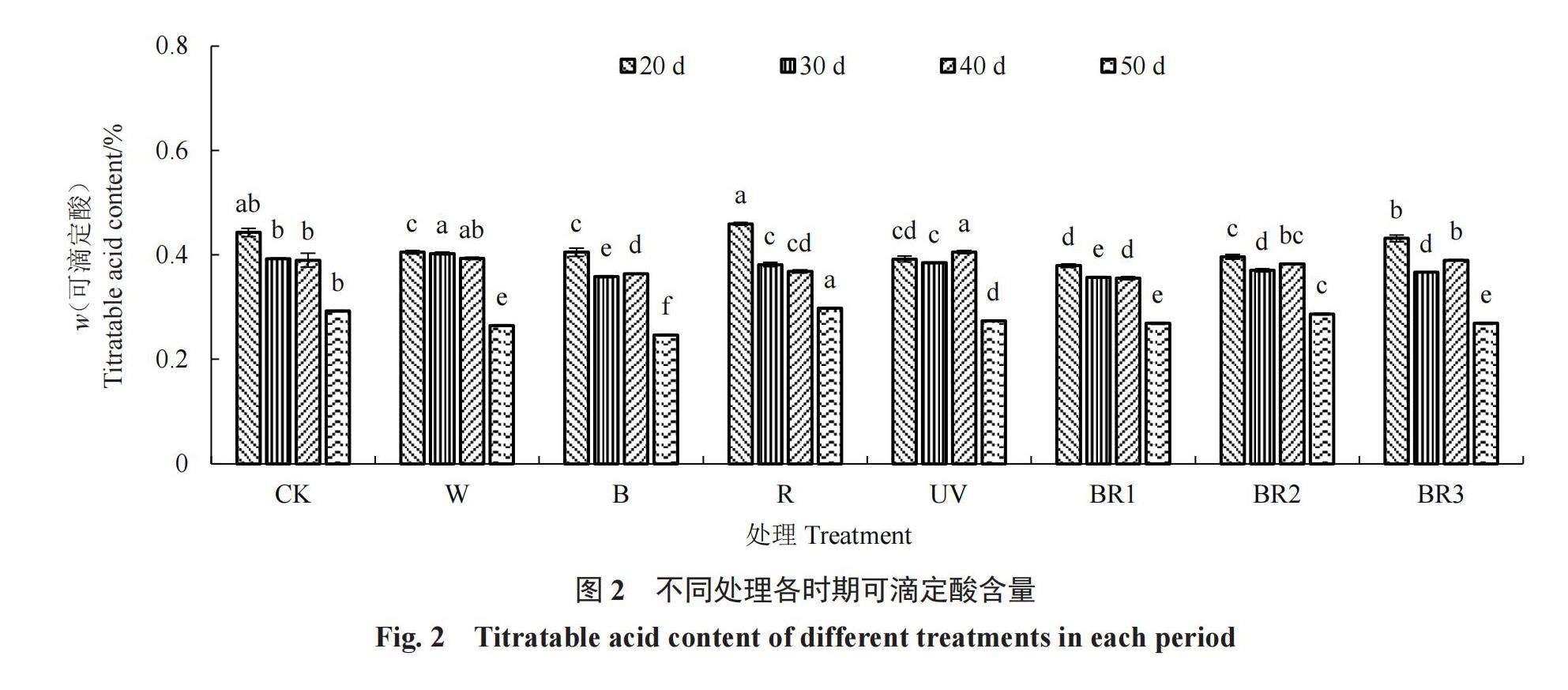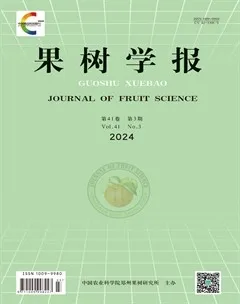不同光質補光對富士蘋果果實品質的影響
王競 唐雪東 程存剛 周江濤 陳艷輝 李鑫 張艷珍 劉炳含



摘? ? 要:【目的】探究不同光質補光對富士蘋果果實品質的影響,為提高蘋果果實品質提供參考依據。【方法】以7年生煙富3/M9-T337為材料,以自然光為對照,設置7個補光處理,分別為白光(W)、藍光(B)、紅光(R)、紫外光(UVA)、紅藍光組合9∶1、6∶1、3∶1(BR1、BR2、BR3),測定果實品質以及色澤形成相關關鍵基因表達差異。【結果】不同光質補光條件下可溶性糖含量BR3>R>B>W>RB2>CK。藍光顯著降低可滴定酸含量。BR3處理顯著增加果實中可溶性固形物含量,達到了對照組的1.18倍。紅光、紫外光、BR3處理維生素C含量分別比對照增加28.35%、18.53%、10.49%。BR3中花青苷含量最高,是對照組的1.6倍。BR3處理色澤形成相關關鍵基因MdDFR、MdUFGT、MdCHS、MdF3H、MdMYB10上調最為顯著,分別是對照組的4.17倍、1.94倍、5.23倍、6.71倍、5.03倍。【結論】BR3處理條件下,果皮中花青苷含量最高,色澤形成相關基因表達量上調最為顯著,同時也能夠增加果實維生素C、可溶性糖、可溶性固形物含量,降低可滴定酸含量,果實品質的提升效果最好。
關鍵詞:蘋果;補光;LED;果實品質
中圖分類號:S661.1 文獻標志碼:A 文章編號:1009-9980(2024)03-0459-11
Effects of light quality on Fuji apple fruit quality
WANG Jing1, 2, TANG Xuedong1*, CHENG Cungang2*, ZHOU Jiangtao2, CHEN Yanhui2, LI Xin2, ZHANG Yanzhen2, LIU Binghan1
(1College of Horticulture, Jilin Agricultural University, Changchun 130118, Jilin, China; 2Research institute of Pomology, Chinese Academy of Agricultural Sciences, Xingcheng 125100, Liaoning, China)
Abstract: 【Objective】 The study explored the effect of light quality on the quality of Fuji apple fruit to found out the best light application scheme. 【Methods】 Using Yanfu 3 as the material, 96 Fuji apple plants with normal and consistent growth were selected and divided into 8 groups, for treatments with natural sun light (CK), white light (W), blue light (B), red light (R), and ultraviolet light (UVA), and mixed light treatments of BR1 (blue light∶red light=1∶9), BR2 (1∶6), and BR3 (1∶3), and 12 plant-based replicates were set in each group. One protective tree was left between the different treatment groups to eliminate mutual interference between the treatments. From May 20th to mid-to-early November, light supplement was carried out at 05:00—07:00 and 18:00—21:00 every day. The light supplement was directly from above the plant, at the same height, 2.5 meters above the ground. The soluble sugars, titratable acids, soluble solids, vitamin C, fruit hardness, fruit coloration and anthocyanin content of apple fruit were determined, and the expression of five key genes related to color formation, including MdDFR (dihydroflavonol reductase), MdUFGT (flavonoid glycosidyltransferase), MdCHS (chalcone synthetase), MdF3H (flavanone 3-hydroxylase) and transcription factor MYB10, were analyzed. 【Results】 Different light quality affected the accumulation of soluble sugars in apple fruit. At 30 days, the soluble sugar content in R, UV, BR2 and BR3 treatment groups increased rapidly, and at 40 days, all treatments increased significantly compared with CK, and at 50 days, the accumulation of soluble sugars in BR3 treatment group was much higher than that in the other treatments, and soluble sugar content was increased by 7.69%, which indicated that BR3 treatment group had the most significant effect in promoting the accumulation of soluble sugars. In addition, single red light, blue light and white light also had great effect on soluble sugar content of fruits, which increased by 5.51%, 5.10% and 3.76%, respectively. The titratable acid content decreased significantly in all treatment groups at 50 days, and the blue light treatment group had the most significant effect in decreasing titratable acid content, which was decreased by 15.6%. The influence of BR1, BR3 and white light was the second, with decreases of 7.91%, 8.11% and 9.33%, respectively. Titratable acid content in BR2 treatment was reduced by only 1.81% compared to the control, but it was 1.85% higher in red light treatment than that of the control. The soluble solids content in all treatment groups were increased at 30 days compared with 20 days, and increased in all treatments except blue light treatment and ultraviolet light treatment at 40 days. At 50 days, the soluble solids content in red light and BR3 was the highest, which was 1.18 times that of the control group, and in the BR2 treatment it was 1.13 times that of the control group. Compared with the control, the soluble solids content in BR1, UVA, W and B increased by 4.50%, 5.05%, 3.86% and 6.86%, respectively. The results of these experiments showed that different light quality could increase the content of soluble solids in fruit, and red light and BR3 treatments had the most significant effect in increasing the content of soluble solids. At 20 days, vitamin C content in the control group, the red light treatment and BR2 treatment group reached the peak value. At 30 days, vitamin C contents in white, blue, ultraviolet, BR1 and BR3 treatment groups reached the highest value. At 40 days, vitamin C content in each treatment group decreased. At 50 days, vitamin C was the highest in the red light treatment group, which increased by 28.35% compared with the control group, followed by the purple light treatment, which increased by 18.53%. Compared with the control group, Vc content in BR1, BR2 and BR3 increased by 10.60%, 4.24% and 10.49%, respectively. White and blue light treatment had the least effect on vitamin C content, increasing by only 1.11% and 1.56%. The hardness of fruit was the highest when the light was supplied for 20 days and higher in all light treatments than that of the control group. As the ripeness of the fruit gradually increased, the hardness of the fruit gradually decreased. At 50 day, BR1, BR2 and BR3 had a significantly higher hardness, which increased by 14.83%, 15.60% and 16.37% compared with the control group, respectively. Red light and blue light increased fruit hardness by 11.76% and 8.95%, respectively. The content of anthocyanins in the peel of each treatment group increased rapidly, and the increase was the most significant at 40 days. At 50 days, the content of anthocyanins in the BR3 treatment group was the highest, which was 1.6 times that of the control group. BR1 and BR2 had only 1.29 times that of the control group. Supplementation of single red light promoted the accumulation of anthocyanins in the peel, which was only 1.13 times that of the control. The addition of white light and blue light did not have a significant effect in the increase of anthocyanin content in the peel. The expression of key genes related to color formation, MdDFR, MdUFGT, MdCHS, MdF3H and MdMYB10 were all regulated, and their expression in BR3 treatment group was the most significantly up-regulated, being 4.17, 1.94, 5.23, 6.71 and 5.03 times that of the control group, respectively. 【Conclusion】 Supplementation of different light quality can increase the content of soluble solids in fruit, and the combination of red light and red blue (3∶1) has the best effect. Red light treatment can increase vitamin C, soluble sugars and titratable acids in the fruit; blue light treatment is effective to reduce the content of titratable acid in the fruit. The combined treatment with red and blue (3∶1) light is most effective in increasing the content of anthocyanins in the peel and the expression of genes related to color formation. The treatment also increases the content of vitamin C, soluble sugars and soluble solids in the fruit, reduces the content of titratable acid, and thus has the best effect in improving the quality of the fruit.
Key words: Apple; Fill light; LED; Fruit quality
我國蘋果栽培面積和產量均居世界首位[1]。富士是我國蘋果的主栽品種,占我國蘋果栽培面積的70%[2]。由于產地與氣候條件的不同,果實品質存在差異[3]。光環境中光質變化對不同植物的果實品質影響顯著[4]。
不同光質補光主要改善了樹體的光照條件,進而影響果實各項指標,包括可溶性糖含量、可滴定酸含量、可溶性固形物含量、維生素C含量、果實硬度、果實色澤、花青苷含量、單果質量、果形指數等[5-8]。研究表明,在設施栽培櫻桃中補光提高櫻桃糖分含量,促進了果實成熟進度,比對照組提早6 d左右[9]。在草莓研究中發現,補光有利于提高設施草莓產量、改善果實外觀和內在品質[10]。補光有利于改善瑞都香玉葡萄果實品質,促進葡萄果實發育、成熟[11]。補光可以促進馬鈴薯營養生長及生物量積累,進而提高馬鈴薯產量、改善塊莖品質[12]。在金鵬1號番茄上的研究發現,補充LED光質能夠增加果實中可溶性固形物含量,提高果實含酸量[13]。崔曉輝等[14]在薄皮甜瓜中研究發現,補光有利于增加果實中可溶性糖含量。在西葫蘆研究中發現,補光處理顯著提高果實中維生素C含量和糖酸比[15]。
花青苷合成是通過苯丙氨酸途徑來實現的,其相關基因主要有二氫黃酮醇還原酶(dihydroflavonol 4-reductase,DFR)、類黃酮糖苷轉移酶(UDP glycose: flavonoid 3-O-glucosyl transferase,UFGT)、查爾酮合成酶(chalcone synthase,CHS)、黃烷酮3-羥化酶(flavanone-3-hydroxylase,F3H)和MdMYB10。
光是蘋果生產過程中的重要環境因素之一,影響蘋果果實品質形成。但目前對于光質調控蘋果果實品質形成的機制尚未見報道。因此筆者以煙富3/M9-T337蘋果為試材,進行不同光質調控,比較果實色澤及內在品質差異,探究光質對果實品質的影響,從而篩選出提高蘋果品質的適宜光質配比,為提高蘋果果實品質提供參考。
1 材料和方法
1.1 試驗材料
試驗于2022年5月開始在遼寧省興城市中國農業科學院果樹研究所溫泉試驗基地蘋果栽培示范園進行,試驗材料為七年生的煙富3,嫁接砧木為M9-T337矮化砧。
1.2 試驗處理
選取生長良好、長勢一致的植株96株,分成8組,自然不補光為對照(CK)、白光(W)、藍光(B)、紅光(R)、紫外光(UVA),以及補光強度組合(藍光∶紅光)BR1(1∶9)、BR2(1∶6)、BR3(1∶3),每組12株重復,每株樹采2個果實用于測定。不同處理組間留有1株保護樹,排除處理間的相互干擾。于9月1日至11月6日進行補光,補光時間為05:00—07:00與18:00—21:00,補光時間總計66 d共330 h,通過定時器來控制不同處理補光時間。果實于幼果期進行套袋處理,于10月12日進行摘袋。果實采收時間為9月30日、10月12日、10月24日、11月6日,當日07:30開始采收,一半用液氮保存后進行后續指標測定,另一半及時進行果實品質相關指標的測定。光源為上海合鳴公司生產50 W圓盤形植物補光燈,補光燈在植株正上方,高度一致,距離地面2.5 m。各處理組其他田間管理一致。土壤pH值為6.9,有機質含量(w,后同)為14.70 g·kg-1,堿解氮含量為88.03 mg·kg-1,速效磷含量為64.64 mg·kg-1,速效鉀含量為128.10 mg·kg-1。
1.3 果實品質指標測定
用水浴恒溫紫外可見分光光度計測定可溶性糖含量;用905全自動電位滴定儀測定可滴定酸含量;用PAL-1型折射儀測定可溶性固形物含量;用905全自動電位滴定儀測定維生素C含量;用TA-HDplus物性分析儀測定果實硬度。
采用紫外可見分光光度計法測定花青苷含量[16],稱取粉碎后的樣品0.2 g于10 mL壓口離心管中,放入5 mL提取液,蓋蓋并搖勻,避光保存24 h,取出放入離心機中50 ℃、6000 r·min-1離心5 min。提取上清液放入10 mL壓口離心管中,用水浴恒溫紫外可見分光光度計進行測定。
采用CM-700d型色差儀測定果實色澤參數(L、a、b、c、h),每次測定前用D65光源,0 ℃觀察角,白色標準色板進行校準;值越大表示樣品表面光澤越好;a值正值為紅色,值越大表示紅色越深;b值正值為黃色,值越大表示黃色越深;h值其變化范圍在0~180°,h<50°時,值越小紅色越深;c值為色飽和度,其值越大表示顏色越純。
采用RNAprep Pure Plant Plus Kit試劑盒(DP441,天根,中國)提取樣品總RNA,以RNA為模板,使用反轉錄試劑盒TransScript?One-Step gDNA removal and cDNA Synthesis SuperMix合成cDNA。
采用試劑盒PerfectStart Green qPCR SuperMix(Vazyme,中國)和熒光定量PCR儀(Bio-Rad,美國)進行實時熒光定量PCR(qRT-PCR)。引物由生工生物工程有限公司合成。引物序列見表1。以MdActin為內參基因,按2-ΔΔCT法計算基因相對表達水平。
1.4 數據處理與分析
使用Excel 2019軟件進行試驗數據整理,采用SAS 9.4進行數據處理分析,檢驗范圍p<0.05為顯著,p<0.01為極顯著。所有試驗均3次重復,結果用“平均值±標準誤”來表示。
2 結果與分析
2.1 不同光質補光對果實內在品質的影響
2.1.1 不同光質補光對果實糖酸含量的影響 由圖1顯示,不同光質補光影響蘋果果實中可溶性糖含量的積累。30 d時R、UV、BR2、BR3處理可溶性糖含量迅速增加,40 d時所有處理可溶性糖含量均同步大幅度上升,50 d時BR3處理可溶性糖含量高于其他處理,與CK相比增加了7.69%,這表明BR3處理對促進可溶性糖含量的積累效果最為顯著。此外,單紅光、藍光和白光也對果實的可溶性糖含量有較大影響,分別比對照增加了5.51%、5.10%、3.76%。
由圖2可知,與其他處理不同,白光與紫外光處理30 d內可滴定酸含量無明顯下降趨勢。紫外光與BR2、BR3處理在40 d時可滴定酸含量略有上升。所有處理均在第50天時可滴定酸含量出現顯著下降,其中藍光處理可滴定酸含量下降最為顯著,下降15.60%。BR1、BR3和白光的影響次之,分別降低了7.91%、8.11%、9.33%。BR2處理與對照相比僅降低了1.81%。紅光處理與對照相比可滴定酸含量升高1.85%。
2.1.2 不同光質補光對果實可溶性固形物含量的影響 由圖3所示,30 d時所有處理的可溶性固形物含量與20 d時相比均呈上升趨勢,40 d時除藍光、紫外光處理以及對照外,其他處理均有所上升。50 d時紅光與BR3處理果實中的可溶性固形物含量最高,達到了對照的1.18倍。BR2處理果實中的可溶性固形物含量達到了對照的1.13倍。而BR1、紫外光、白光和藍光處理與對照相比,果實中可溶性固形物含量分別提高4.50%、5.05%、3.86%、6.86%。試驗結果表明,不同光質補光均能提高果實中可溶性固形物含量,其中紅光和BR3處理對增加果實中可溶性固形物含量的作用最為顯著。
2.1.3 不同光質補光對果實維生素C含量的影響 由圖4可知,20 d時對照與紅光以及BR2處理維生素C含量達到峰值。30 d時白光、藍光、紫外光、BR1以及BR3處理維生素C含量達到峰值。40 d時各處理維生素C含量均有所下降。50 d時紅光處理果實中維生素C含量最高,與對照相比增加了28.35%,其次為紫外光處理,增加了18.53%。BR1、BR2和BR3三個處理與對照相比,分別顯著增加了10.60%、4.24%、10.49%。白光處理對維生素C含量影響最小,僅增加了1.11%,藍光處理使維生素C含量顯著減少6.44%。
2.1.4 不同光質補光對果實硬度的影響 補光20 d時果實硬度最高,不同補光處理的果實硬度均高于對照。隨著果實成熟度逐漸增加,果實硬度逐漸降低。在50 d時,BR1、BR2、BR3三個處理均顯著增加了果實的硬度,與對照相比分別提高14.83%、15.60%、16.37%。紅光和藍光與對照相比分別顯著提高了11.76%、8.95%(圖5)。
2.2 不同光質補光對果實外在品質的影響
2.2.1 不同光質補光對果實著色的影響 由表2可知,在40 d時,L、b、h降低,a值與c值增大。在50 d時,一定程度上補光降低了L、b、h值,增大了a值和c值,與對照相比不同光質補光均降低了L值,其中BR1處理最為顯著,降低了14.97%。白光、紅光和紫外光處理的a值分別比對照顯著增大16.02%、17.05%、17.65%,而藍光處理僅增大10.19%。另外,紅藍組合光處理相較于對照a值分別增大18.31%、11.42%、16.45%。此外,BR1處理對c值的增大效果最為顯著。與對照相比各處理均降低了h值。綜上所述,不同光質補光均能促進果實著色,但促進的效果不同,BR3處理促進果實著色效果最為顯著。
2.2.2 不同光質補光對果實花青苷含量的影響 由圖6可知,20 d為果實未摘袋條件下的果皮花青苷含量,其含量較低。30 d為果實剛摘袋條件下果皮中花青苷含量,無明顯變化。40 d時各處理的果皮花青苷含量迅速上升,上升幅度最為顯著。50 d時BR3處理的果皮花青苷含量最高,是對照的1.6倍。BR1和BR2在一定程度上提升果皮中花青苷含量,是對照的1.29倍,但顯著低于BR3處理。補充單紅光也能促進果皮中花青苷的積累,但相對于對照,僅有1.13倍的增加效果。而補充白光和藍光對果皮花青苷含量的增加并沒有顯著作用。
熒光定量PCR分析了蘋果果皮中5個花青苷合成相關基因的表達水平(圖7)。在50 d時,BR1與BR3處理MdDFR基因表達量顯著上調。在20 d時,UV處理MdMYB10基因表達量顯著上調。在20 d與50 d時,BR3處理MdF3H基因表達量上調顯著,50 d時W與BR1處理基因表達量增加。在40 d時,各補光處理MdCHS基因表達量均上調。在20 d時,BR3處理MdUFGT基因表達量上調最為顯著。在50 d時,BR3處理MdDFR和MdF3H基因表達量顯著上調,分別是對照的4.17倍、6.71倍,MdMYB10、MdCHS、MdUFGT基因表達量均有所上調,是對照的5.03倍、5.23倍、1.94倍。
3 討 論
3.1 不同光質對果實外在品質的影響
果實色澤、果形指數、單果質量、果實硬度等都是果實外在品質的重要指標。果實的紅或紫色是花青素的顏色,通常以花青苷的形式存在[17]。蘋果果皮中的紅色色素主要是花青苷,花青苷含量越高果皮著色越佳。查倩等[18]研究發現,轉色期對巨峰葡萄補光顯著增加了果實中花色苷的含量,明顯改善紅色系葡萄著色,提高果實品質。在設施草莓研究中發現,補光能夠改善草莓果實的外觀品質,且紅藍(3∶1)組合光處理下效果顯著[19]。在黃瓜研究中也有相同的發現,紅藍組合光能夠改善黃瓜果實的外觀品質,紅藍組合光(3∶1)顯著高于其他組合[20]。本研究結果表明,紅藍(3∶1)光處理下,果實著色效果最佳,果皮花青苷含量增加效果最為顯著,是對照的1.6倍。紅藍(9∶1)、紅藍(6∶1)、紅藍(3∶1)、紅光、藍光5種補光處理下蘋果果實硬度顯著高于對照,且分別較對照高14.83%、15.60%、16.37%、11.76%、8.95%。由此表明,在蘋果栽培中,采用紅藍組合光進行補光可以顯著改善蘋果果實的外觀品質。
3.2 不同光質對果實內在品質的影響
可溶性糖、可滴定酸、可溶性固形物、維生素C等物質的含量是決定果實內在品質的重要指標,不同光質補光對果實內在品質影響較大,從而可通過調節光質來改善果實內在品質。在草莓研究中發現,增加紅光可提高草莓果實中的可溶性糖與維生素C含量[21-22]。在番茄研究中也得到了相同的結論,紅色光質顯著提高了番茄果實維生素C含量[23-24]。時曉芳等[25]采用不同光質對陽光玫瑰葡萄補光發現,果實發育后期補充紅光有利于果實中可溶性固形物的積累。設施紅地球葡萄研究中發現,不同光質補光均能增加果實中可溶性糖、可溶性固形物以及花青苷的含量[26]。在南高叢越橘上研究發現,紅藍光(3∶1)能夠顯著提高果實可溶性糖、花青苷、可溶性固形物含量[27]。以上試驗結果與本實驗結論一致。在本研究中,紅光處理與對照相比果實維生素C含量增加了28.35%,在紅藍組合光(3∶1)處理下蘋果果實可溶性糖和可溶性固形物含量最高,同時也較為顯著地降低了果實中可滴定酸含量。以上研究結果表明,不同光質補光能改善蘋果果實品質,但光質如何影響植物基因表達、物質合成和轉運等過程,從而調控蘋果果實品質的機制尚不清楚。
用單一光源進行補光時,紅光的作用非常明顯。Osman等[28]研究發現紅光有利于蘿卜芽苗菜生長,提高產量,增加維生素C含量。紅光有利于提高葉片中葉綠素含量,藍光則降低了葉片中葉綠素的含量。研究發現增強紅色波段光,果實品質較對照有明顯提高,用不同光質處理番茄,發現紅光可以顯著提高果實可溶性糖和有機酸含量[29]。本研究結果表明,紅光可以顯著提高蘋果果實中可溶性糖和可滴定酸的含量,并且還能增加維生素C的含量。相比之下,藍光和紫外光對果實品質的作用相對較弱。本研究結果表明,藍光和紫外光可以降低蘋果果實中可滴定酸的含量,紫外光能有效促進果實的著色,增加果皮中花青苷的含量。
紅光與藍光對植物生長發育的作用存在差異,紅藍組合光則可以彌補兩者不足,結合紅光及藍光的個體補光優勢,更有利于植物的形態建成以及生長發育。紅藍混合LED補光能顯著提高葡萄[11]、番茄[13]、甜瓜[14]的可溶性固形物、果糖、葡萄糖和蔗糖含量。適合比例的紅藍組合光能提高草莓果實的糖含量[10]。陳祥偉等[30]的補光研究結果表明,紅藍組合光處理下小白菜生長發育、光合特性及品質指標均顯著高于其他處理。在溫室甜椒上研究發現,紅藍組合光能夠增加果實中可溶性糖的含量[31]。在生菜研究中發現,紅藍組合光能夠增加生菜中抗壞血酸的含量[32]。
果皮的發紅是由花青素的種類和含量決定的。花青素生物合成基因的表達由MBW復合物決定,該復合物由MYB、bHLH和WD40三種轉錄因子組成。MYB蛋白可直接與編碼查爾酮合酶(CHS)、查爾酮異構酶(CHI)、黃烷酮-3-羥化酶(F3H)、類黃酮3-羥化酶(F3′H)和黃酮醇合酶(FLS)的花青素生物合成基因啟動子結合。蘋果花青素生物合成中的關鍵MYB調節因子是MdMYB10[33]。MdMYB10通過激活編碼二氫黃酮醇4-還原酶(DFR)和類黃酮3-葡萄糖基轉移酶(UFGT)等花青素合成基因來促進花青素的積累[34]。當花青素生物合成基因表達量上調時,花青苷的含量隨之上升。
4 結 論
當紅光和藍光的比例為3∶1時,對蘋果品質的提升效果最佳。紅藍3∶1組合光不僅可以顯著提高蘋果果實的糖含量和可溶性固形物含量,同時還能明顯降低可滴定酸的含量,促進蘋果果皮中花青苷的合成,加速著色,提高果實品質。綜上所述,紅藍3∶1組合光對蘋果品質的提升起到最為顯著的作用。
參考文獻 References:
[1] 陳學森,韓明玉,蘇桂林,劉鳳之,過國南,姜遠茂,毛志泉,彭福田,束懷瑞. 當今世界蘋果產業發展趨勢及我國蘋果產業優質高效發展意見[J]. 果樹學報,2010,27(4):598-604.
CHEN Xuesen,HAN Mingyu,SU Guilin,LIU Fengzhi,GUO Guonan,JIANG Yuanmao,MAO Zhiquan,PENG Futian,SHU Huairui. Discussion on todays world apple industry trends and the suggestions on sustainable and efficient development of apple industry in China[J]. Journal of Fruit Science,2010,27(4):598-604.
[2] 匡立學,徐國鋒,陳志軍,李銀萍,程楊,沈友明. 2017年中國‘富士蘋果品質數據集[J]. 農業大數據學報,2022,4(3):49-53.
KUANG Lixue,XU Guofeng,CHEN Zhijun,LI Yinping,CHENG Yang,SHEN Youming. Quality datasets of ‘Fuji apples cultivated in China in 2017[J]. Journal of Agricultural Big Data,2022,4(3):49-53.
[3] 李卓,郭玉蓉,孫立軍,劉婧琳,李景景,付成程. 不同產地長富2號蘋果品質差異及其與地理坐標的相關性[J]. 陜西師范大學學報(自然科學版),2012,40(4):98-103.
LI Zhuo,GUO Yurong,SUN Lijun,LIU Jinglin,LI Jingjing,FU Chengcheng. Quality differences of Nagafu 2 apple from different habitats and its correlation with geographical coordinates[J]. Journal of Shaanxi Normal University (Natural Science Edition),2012,40(4):98-103.
[4] 李元景,曹兵,萬仲武,張悅,馬沖. 不同光質對靈武長棗生長與光合特性的影響[J]. 經濟林研究,2022,40(3):77-86.
LI Yuanjing,CAO Bing,WAN Zhongwu,ZHANG Yue,MA Chong. Effect of light quality on growth and photosynthetic characteristics of ‘Lingwuchangzao[J]. Non-wood Forest Research,2022,40(3):77-86.
[5] YANG W H,ZHU X C,BU J H,HU G B,WANG H C,HUANG X M. Effects of bagging on fruit development and quality in cross-winter off-season Longan[J]. Scientia Horticulturae,2009,120(2):194-200.
[6] ASREY R,KUMAR K,SHARMA R R,MEENA N K. Fruit bagging and bag color affects physico-chemical,nutraceutical quality and consumer acceptability of pomegranate (Punica granatum L.) arils[J]. Journal of Food Science and Technology,2020,57(4):1469-1476.
[7] 王子盾,王輝,馮郁晨,張學良,閆雷玉,劉小杰,趙政陽.不同顏色育果袋對‘瑞雪蘋果果實品質的影響[J]. 中國農業科學,2023,56(4):729-740.
WANG Zidun,WANG Hui,FENG Yuchen,ZHANG Xueliang,YAN Leiyu,LIU Xiaojie,ZHAO Zhengyang. Effects of different color fruit bags on fruit quality of ‘Ruixue apple[J]. China Agricultural Sciences,2023,56(4):729-740.
[8] WANG S Y,FANG H,XIE J M,WU Y,TANG Z Q,LIU Z C,LV J,YU J H. Physiological responses of cucumber seedlings to different supplemental light duration of red and blue LED[J]. Frontiers in Plant Science,2021,12:709313.
[9] 李都岳,吳延軍. 補光對設施栽培櫻桃果實成熟和糖分積累的影響[J]. 果樹學報,2023,40(10):2183-2194..
LI Duyue,WU Yanjun. Effects of supplementary light on ripening and sugar accumulation of cherry under protected cultivation[J]. Journal of Fruit Science,2023,40(10):2183-2194.
[10] 楊肖芳,張豫超,苗立祥,孫晨棟,蔣桂華. LED補光對不同設施栽培草莓品種營養生長與果實品質的影響[J]. 浙江農業科學,2023,64(4):864-869.
YANG Xiaofang,ZHANG Yuchao,MIAO Lixiang,SUN Chendong,JIANG Guihua. Effects of LED supplementary light on the nutritional growth and fruit quality of strawberry varieties cultivated in different facilities[J]. Journal of Zhejiang Agricultural Sciences,2023,64(4):864-869.
[11] 張克坤,劉鳳之,王孝娣,史祥賓,王寶亮,鄭曉翠,冀曉昊,王海波. 不同光質補光對促早栽培‘瑞都香玉葡萄果實品質的影響[J]. 應用生態學報,2017,28(1):115-126.
ZHANG Kekun,LIU Fengzhi,WANG Xiaodi,SHI Xiangbin,WANG Baoliang,ZHENG Xiaocui,JI Xiaohao,WANG Haibo. Effects of supplementary light with different wavelengths on fruit quality of ‘Ruidu Xiangyu grape under promoted cultivation[J]. Chinese Journal of Applied Ecology,2017,28(1):115-126.
[12] 彭佃亮,遲文娟,信國琛,唐玉海,張敬敏. 不同時段補光對日光溫室早春茬馬鈴薯光合特性、產量和品質的影響[J]. 中國瓜菜,2022,35(1):65-69.
PENG Dianliang,CHI Wenjuan,XIN Guochen,TANG Yuhai,ZHANG Jingmin. Effect of supplemental illumination in different periods on photosynthetic characteristics,yield and quality of potato in solar greenhouse[J]. China Cucurbits and Vegetables,2022,35(1):65-69.
[13] 于經緯,羅博特,岳釘伊. 不同CO2濃度與LED補光組合對番茄果實品質的影響[J]. 農村經濟與科技,2017,28(8):41-42.
YU Jingwei,LUO Bote,YUE Dingyi. Effects of different CO2 concentrations and LED supplemental light combinations on tomato fruit quality[J]. Rural Economy and Science-Technology,2017,28(8):41-42.
[14] 崔曉輝,郭小鷗,孫天宇,齊紅巖. LED補光對薄皮甜瓜幼苗生長及果實品質的影響[J]. 植物生理學報,2017,53(4):657-667.
CUI Xiaohui,GUO Xiaoou,SUN Tianyu,QI Hongyan. Effects of LED supplementary lighting on seedling growth and fruit quality of oriental melon[J]. Plant Physiology Journal,2017,53(4):657-667.
[15] 王舒亞,徐威,唐中祺,王鵬,景濤,劉琪,馬正宇,呂劍,郁繼華. 不同補光時長對日光溫室西葫蘆生長、品質及產量的影響[J]. 中國瓜菜,2020,33(4):23-27.
WANG Shuya,XU Wei,TANG Zhongqi,WANG Peng,JING Tao,LIU Qi,MA Zhengyu,L? Jian,YU Jihua. Effects of different duration of light supplementation on growth,quality and yield of Cucurbita pepo in greenhouse[J]. China Cucurbits and Vegetables,2020,33(4):23-27.
[16] 張華磊,毛柯,劉志,謝興斌,馮曉明,郝玉金. MdMYB1轉錄因子調控紅星蘋果果實著色的計算機模擬分析及表達驗證[J]. 園藝學報,2009,36(11):1581-1588.
ZHANG Hualei,MAO Ke,LIU Zhi,XIE Xingbin,FENG Xiaoming,HAO Yujin. In silico analysis and expression confirmation of the regulation of fruit coloration by transcriptional factor MdMBY1 in delicious apple[J]. Acta Horticulturae Sinica,2009,36(11):1581-1588.
[17] 高原,孫百靈,曲柏宏. 果樹果實著色研究進展[J]. 湖南農業科學,2011(22):25-26.
GAO Yuan,SUN Bailing,QU Baihong. Research progress on fruit coloring of fruit trees[J]. Hunan Agricultural Sciences,2011(22):25-26.
[18] 查倩,奚曉軍,殷向靜,蔣愛麗. 轉色期補光處理對鮮食葡萄‘巨峰和‘巨玫瑰果實品質的影響[J]. 中國農學通報,2022,38(31):55-59.
ZHA Qian,XI Xiaojun,YIN Xiangjing,JIANG Aili. Effects of supplementary lighting in veraison period on fruit quality of table grape ‘Kyoho and ‘Jumeigui[J]. Chinese Agricultural Science Bulletin,2022,38(31):55-59.
[19] 陽圣瑩,白勝,蔣浩宏,朱亮,周霓,李曦怡,朱潤華. 不同補光處理對設施草莓光合特性及果實品質的影響[J]. 山西農業科學,2016,44(9):1298-1303.
YANG Shengying,BAI Sheng,JIANG Haohong,ZHU Liang,ZHOU Ni,LI Xiyi,ZHU Runhua. Effects of different supplemental lighting treatments on photosynthetic characteristics and fruit quality of strawberry in greenhouse[J]. Journal of Shanxi Agricultural Sciences,2016,44(9):1298-1303.
[20] 劉曉英,徐文棟,焦學磊,徐志剛. 不同配比紅藍LED光對黃瓜果實產量和品質的影響[J]. 植物資源與環境學報,2016,25(2):80-84.
LIU Xiaoying,XU Wendong,JIAO Xuelei,XU Zhigang. Effect of different proportions of red and blue LED lights on yield and quality of fruit of Cucumis sativus[J]. Journal of Plant Resources and Environment,2016,25(2):80-84.
[21] 吳鵬飛,王麗娟,劉昭,切巖祥和. LED補光對設施草莓生長及果實品質的影響[J]. 北方園藝,2016(21):48-50.
WU Pengfei,WANG Lijuan,LIU Zhao,KIRRIIWAYoshikazu. Effect of LED supplemental lighting treatment on protected strawberry growth and fruit quality[J]. Northern Horticulture,2016(21):48-50.
[22] 徐凱,郭延平,張上隆,戴文圣,符慶功. 不同光質膜對草莓果實品質的影響[J]. 園藝學報,2007,34(3):585-590.
XU Kai,GUO Yanping,ZHANG Shanglong,DAI Wensheng,FU Qinggong. Effect of light quality on the fruit quality of ‘Toyonoka strawberry (Fragaria × ananassa Duch.)[J]. Acta Horticulturae Sinica,2007,34(3):585-590.
[23] 楊忠武,劉翼,金卓君,徐衛紅. 光質對番茄營養與風味品質的影響[J]. 中國農學通報,2020,36(34):134-141.
YANG Zhongwu,LIU Yi,JIN Zhuojun,XU Weihong. Effects of light quality on nutrition and flavor quality in tomato[J]. Chinese Agricultural Science Bulletin,2020,36(34):134-141.
[24] SONG Y J,TEAKLE G,LILLYWHITE R. Unravelling effects of red/far-red light on nutritional quality and the role and mechanism in regulating lycopene synthesis in postharvest cherry tomatoes[J]. Food Chemistry,2023,414:135690.
[25] 時曉芳,林玲,白先進,郭榮榮,謝林君,白揚,韓佳宇,張瑛,林玲,曹雄軍. 陽光玫瑰葡萄果實生長發育及品質對不同光質的響應[J]. 南方農業學報,2021,52(6):1641-1647.
SHI Xiaofang,LIN Ling,BAI Xianjin,GUO Rongrong,XIE Linjun,BAI Yang,HAN Jiayu,ZHANG Ying,LIN Ling,CAO Xiongjun. Response of berries development and quality of Shine Muscat grape to different light qualities[J]. Journal of Southern Agriculture,2021,52(6):1641-1647.
[26] 劉帥,徐偉榮,張亞紅,劉鑫,郭松濤,胡莉. 基于轉錄組研究補光對設施‘紅地球葡萄萌芽的影響[J]. 果樹學報,2021,38(3):305-317.
LIU Shuai,XU Weirong,ZHANG Yahong,LIU Xin,GUO Songtao,HU Li. Effects of supplementary light on the bud burst of ‘Red Globe grape under protected cultivation based on transcriptome sequencing[J]. Journal of Fruit Science,2021,38(3):305-317.
[27] 王佳淇,何瑩鈺,韋曉桐,李永強,楊莉,陳文榮,廖芳蕾,郭衛東. LED補光組合對大棚越橘生長發育的影響[J]. 園藝學報,2020,47(6):1183-1193.
WANG Jiaqi,HE Yingyu,WEI Xiaotong,LI Yongqiang,YANG Li,CHEN Wenrong,LIAO Fanglei,GUO Weidong. Effects of LED supplemental light on the growth and development of blueberry in greenhouse[J]. Acta Horticulturae Sinica,2020,47(6):1183-1193.
[28] OSMAN A B,DODD P B. Changes in some physical and chemical characteristics of strawberry (Fragaria × ananassa Duchesne) cv. Ostara grown under different shading levels[J]. Acta Horticulturae,1992(292):195-208.
[29] 樊小雪,凌丹丹,徐剛,高文瑞,孫艷軍,韓冰. 不同LED光照對番茄果實品質和糖類物質含量的影響[J]. 江蘇農業學報,2021,37(4):944-948.
FAN Xiaoxue,LING Dandan,XU Gang,GAO Wenrui,SUN Yanjun,HAN Bing. Effects of different LED light on fruit quality and sugar content of tomato[J]. Jiangsu Journal of Agricultural Sciences,2021,37(4):944-948.
[30] 陳祥偉,劉世琦,成波,劉慶,馬桂芹. 不同LED光源對小白菜生長及品質的影響[J]. 長江蔬菜,2013(16):36-40.
CHEN Xiangwei,LIU Shiqi,CHENG Bo,LIU Qing,MA Guiqin. Effects of different LED light sources on growth and nutritional quality of pakchoi[J]. Journal of Changjiang Vegetables,2013(16):36-40.
[31] KIM D,RA I,SON J E. Fruit quality and volatile compounds of greenhouse sweet peppers as affected by the LED spectrum of supplementary interlighting[J]. Journal of the Science of Food and Agriculture,2023,103(5):2593-2601.
[32] ZHA L Y,LIU W K,YANG Q C,ZHANG Y B,ZHOU C B,SHAO M J. Regulation of ascorbate accumulation and metabolism in lettuce by the red:Blue ratio of continuous light using LEDs[J]. Frontiers in Plant Science,2020,11:704.
[33] LIU Y,GAO X H,TONG L,LIU M Z,ZHOU X K,TAHIR M M,XING L B,MA J J,AN N,ZHAO C P,YAO J L,ZHANG D. Multi-omics analyses reveal MdMYB10 hypermethylation being responsible for a bud sport of apple fruit color[J]. Horticulture Research,2022,9:uhac179.
[34] ESPLEY R V,HELLENS R P,PUTTERILL J,STEVENSON D E,KUTTY-AMMA S,ALLAN A C. Red colouration in apple fruit is due to the activity of the MYB transcription factor,MdMYB10[J]. The Plant Journal,2007,49(3):414-427.

